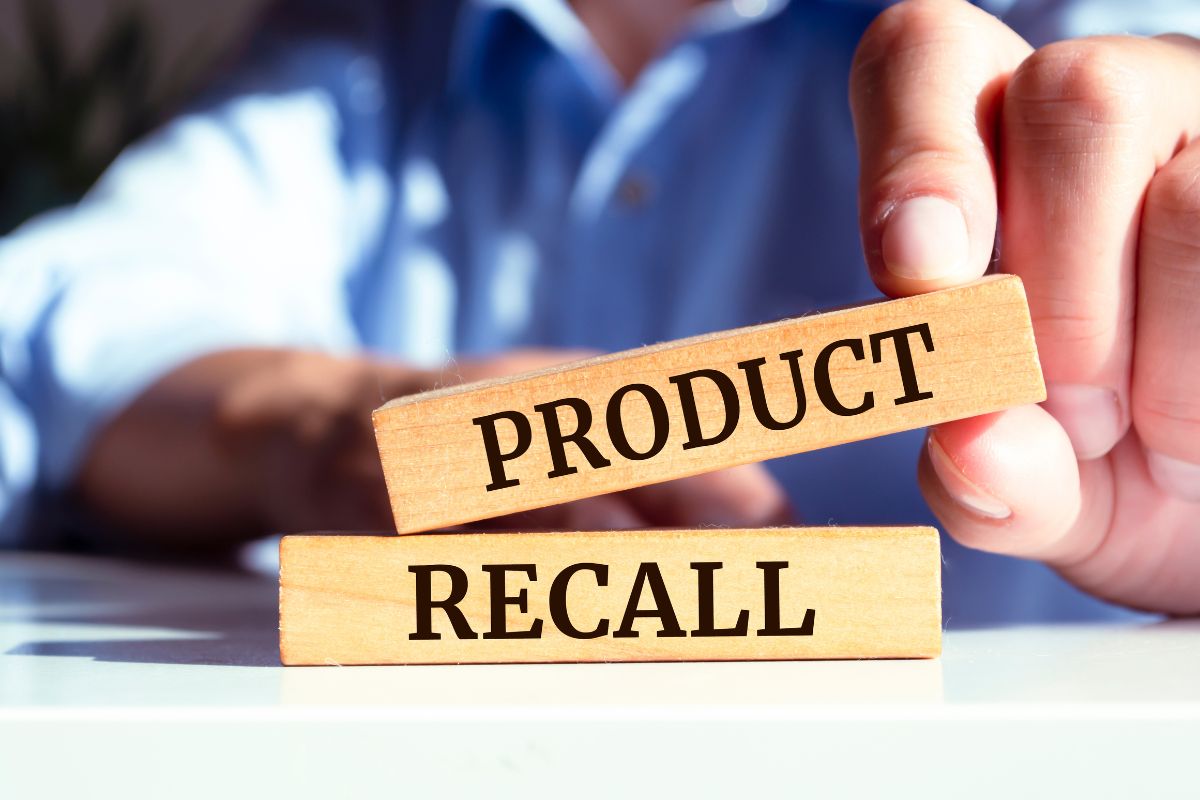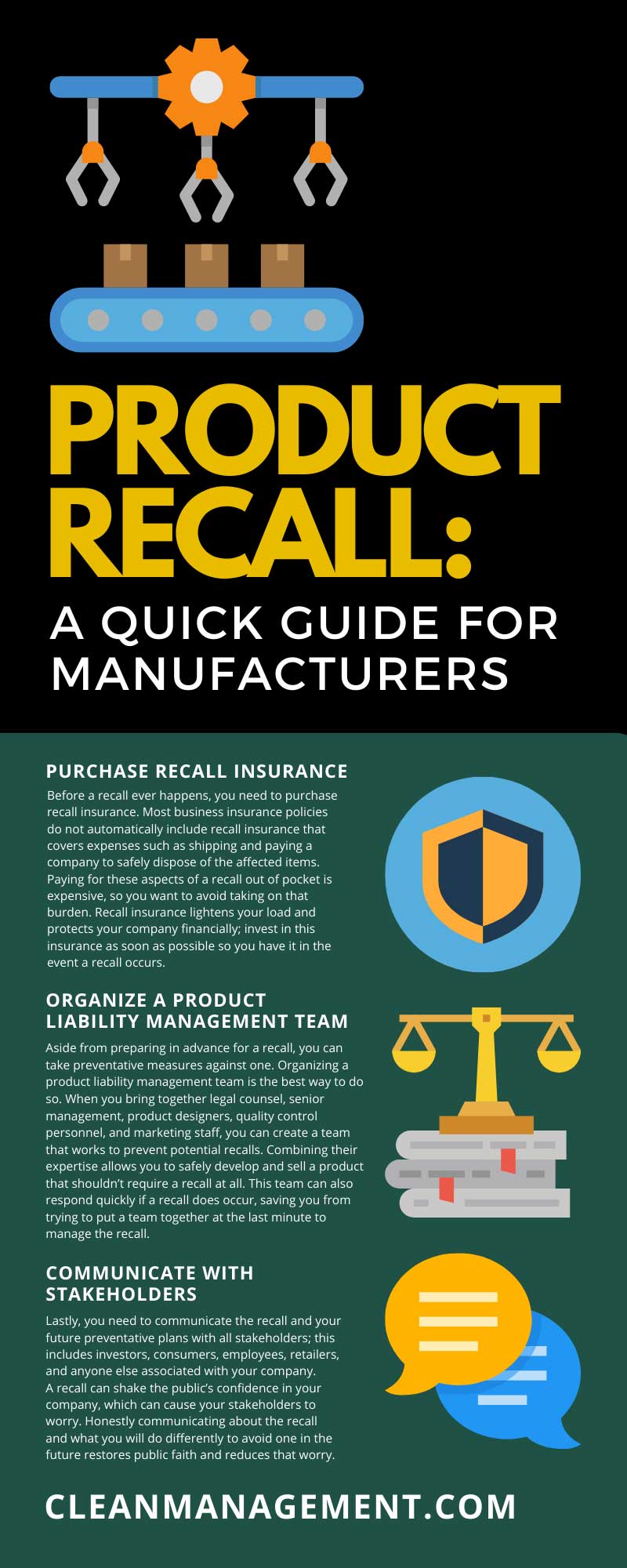Product Recall: A Quick Guide for Manufacturers

Recalls are an unfortunate part of business. All types of recalls are on the rise, from various products such as car parts to different food items. While manufacturers do their best to avoid recalls, sometimes they must occur anyway. Managing a product recall is stressful, so we’ve compiled a quick guide for manufacturers to help you through the process. Each step provided builds on the last one, so you can take it one step at a time and bring success to your company post-recall.
Purchase Recall Insurance
Before a recall ever happens, you need to purchase recall insurance. Most business insurance policies do not automatically include recall insurance that covers expenses such as shipping and paying a company to safely dispose of the affected items. Paying for these aspects of a recall out of pocket is expensive, so you want to avoid taking on that burden. Recall insurance lightens your load and protects your company financially; invest in this insurance as soon as possible so you have it in the event a recall occurs.
Organize a Product Liability Management Team
Aside from preparing in advance for a recall, you can take preventative measures against one. Organizing a product liability management team is the best way to do so. When you bring together legal counsel, senior management, product designers, quality control personnel, and marketing staff, you can create a team that works to prevent potential recalls. Combining their expertise allows you to safely develop and sell a product that shouldn’t require a recall at all. This team can also respond quickly if a recall does occur, saving you from trying to put a team together at the last minute to manage the recall.
Verify All Recall Information
Preventative measures don’t guarantee that a recall won’t occur. If you learn that a product has a problem and may require a recall, you must start the recall process. The first step of the recall process is to verify all the related information. Ask about the incidents that occurred and the specific defects people noticed in the product. Find out where the products in question were sold and where the incidences occurred. Learn which standards apply to the product and what communication method will work best for sharing the recall information.
Comply With Regulatory Recall Requirements
The US Consumer Product Safety Commission, or CPSC, regulates all consumer product recalls, including off-spec and outdated products. You must notify this regulatory body of a consumer product recall and comply with all their recall requirements. Some CPSC requirements include ceasing production of the recalled product, isolating the recalled inventory, and testing a replacement or repair. CPSC will also expect notice documents, which can consist of a toll-free phone number for people to call, website links for recall information, and retail notification posters. Your legal team and the people at CPSC can help you navigate these recall requirements.
Determine and Execute a Response
CPSC recall requirements will help you determine and execute an appropriate response. There are three main response options: product return, product repair, and notification.
In a product return scenario, you will notify consumers of the recall and ask them to return the products to your company. From there, you will most likely need to dispose of the recalled items to prevent accidental or illegal redistribution.
With a product repair, you will develop a repair for the product, alert consumers about the need for the product repair, and repair the products for them. Consumers can bring or mail the products to a designated location, and you will then return the fixed products to them.
Some recalls only require a consumer notification, such as when a product only breaks under specific circumstances like excessive heat. You will send out a notification through the appropriate channels, such as emailing consumers directly and posting details of the notification on your social media pages.
Ideally, your product liability management team will help create and execute the required recall response. If you did not create a management team before the recall, you should assemble one before moving forward to allow all the necessary teams to communicate with each other quickly and effectively. Be sure to retain this team to help prevent future recalls.
Notify Your Insurance Company
You will also need to notify your insurance company that you are filing a claim on your recall insurance. The company should then provide the funding for recall expenses, such as shipping repair parts to retailers. If you do not have recall insurance, you can still ask your insurance provider if there is any financial assistance available. You should also strongly consider purchasing recall insurance to protect your business from losing money on any future recalls.
Record Recall Expenses
Some insurance providers only reimburse for specific recall expenses. This means that you must carefully record all associated expenses so you can submit them to your insurance provider once the recall is complete. If consumers attempt to open litigation against you due to the recall, you may need these financial records to prove that your business responded correctly. Recall expenses can also affect your taxes, so you should plan on storing these records for several years.
Communicate With Stakeholders
Lastly, you need to communicate the recall and your future preventative plans with all stakeholders; this includes investors, consumers, employees, retailers, and anyone else associated with your company. A recall can shake the public’s confidence in your company, which can cause your stakeholders to worry. Honestly communicating about the recall and what you will do differently to avoid one in the future restores public faith and reduces that worry.
This quick guide for manufacturers takes you step-by-step through the necessary response to a product recall. While a recall is a stressful, lengthy process, your company can survive and even thrive afterward. If you need assistance with secure product destruction during or after your recall, Clean Management Environmental Group is happy to help. We offer various destruction methods, including environmentally friendly options like incineration and composting. These methods are available for a wide array of products, from coffee cups with defective logos to off-spec children’s toys. Contact Clean Management Environmental Group for more information about our services.

